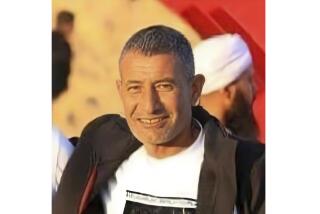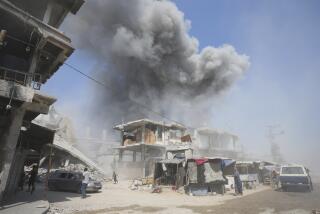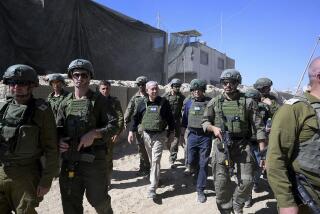Israel says missing soldier was killed in Gaza, not captured
Reporting from Gaza City — Israel’s military concluded early Sunday that a soldier thought to have been captured by Palestinian militants was actually killed in combat in the Gaza Strip.
The news came after a day in which Israeli forces raked the southern tip of Gaza with airstrikes and shelling and the country’s leaders said they were closing in on their goal of eliminating tunnels built by the militant group Hamas.
“In these hours, our forces are completing the mission to bomb and neutralize the terror tunnels in Gaza,” Prime Minister Benjamin Netanyahu said in a Saturday evening news conference. Hamas fighters had sown fear by using the tunnels to cross into Israel.
At the news conference, Netanyahu answered questions about the missing soldier, 2nd Lt. Hadar Goldin, saying he intended to speak to his family later.
A few hours later, about 2 a.m. Sunday, the Israeli military announced that the missing soldier had been killed in action. Goldin was posthumously promoted to lieutenant, Lt. Col. Peter Lerner said in a series of Twitter posts.
It was not clear precisely how Israel determined that Goldin was killed.
The military wing of Hamas, however, had already suggested that the missing soldier was dead. Israelis had feared that had he been captured, he would have given Hamas a major bargaining chip in any peace or truce talks.
As it was, in the wake of Friday’s collapse of a cease-fire painstakingly crafted by international mediators, Saturday saw little apparent movement by key players to revive hope for a truce. After 26 days of conflict, there were some indications that Israel might simply pull back its forces when it believed they had accomplished their mission, rather than entering into talks that might result in cease-fire provisions rewarding Hamas in some way.
Perhaps suggesting a pullback from highly populated areas, where Israel has been criticized for inflicting a large number of civilian casualties, Netanyahu said that the Israel Defense Forces would now “deploy along areas that are convenient for us in order to reduce friction for IDF soldiers, and we will continue the operation until we reach its objective.”
At the same news conference at which Netanyahu spoke, Defense Minister Moshe Yaalon said the military was “nearing completion of the destruction of Gaza’s attack tunnels.”
He added that Israel had dealt a harsh blow generally to Hamas’ ability to inflict damage. “Let there be no mistakes: Hamas is paying a very heavy price,” and will continue to pay, he said.
The fighting broke out on July 8 with Israeli airstrikes that expanded the next week into a ground offensive. It has so far claimed the lives of nearly 1,700 Palestinians, most of them civilians, and more than 60 Israeli troops, the country’s largest single-conflict military loss in nearly a decade.
In Rafah, which lies on Gaza’s border with Egypt, Israeli strikes appeared intended to isolate the area where Palestinian militants rose up out of an underground passageway and apparently killed three Israeli troops, one of them Goldin.
When it appeared that he had been captured, both the United States and the United Nations had called for Goldin’s unconditional release, but the military wing of Hamas distanced itself from the incident rather than demanding any concessions in exchange for his release, suggesting that some militant squadrons might have been operating without answering to any central command.
Hamas said it had not been in contact with the fighters who took part in the ambush, and suggested that Israeli heavy airstrikes in the aftermath of the clash had probably killed all those involved anyway.
“Assuming that they managed to seize the soldier ... we assess that he was also killed,” the Izzidin al-Qassam Brigade said in a statement.
The Rafah bombardment has killed scores of Palestinians and forced many others to flee, adding to the burden of what was already believed to be a displaced population numbering about a quarter of a million.
Residents described desperate conditions including a power cutoff and overwhelmed medical personnel, with many residents moving out of an area that was being shelled or bombarded only to find themselves under attack again.
While most of Saturday’s firepower was concentrated on Rafah, Israeli airstrikes continued to hit targets in Gaza City, including Islamic University, which has ties to Hamas.
Israeli towns and cities, meanwhile, came under continuing rocket fire from Gaza, with the Sabbath punctuated by the periodic din of sirens.
Most of the projectiles fired toward Israel have either been intercepted by Israel’s Iron Dome antimissile defense system, created with U.S. assistance, or fallen on open ground.
The Israeli military Saturday told Palestinians that they could return to some devastated areas in the northern part of Gaza, including Beit Lahiya, which suffered heavy damage and casualties in the last two weeks as Israeli troops sought to root out militant-dug tunnels. Hamas said the pullback represented a defeat for the Israeli army.
“Any unilateral Israeli withdrawal is a declaration of the failure of its military campaign in the Gaza Strip,” spokesman Sami Abu Zuhri said on Hamas’ Al Aqsa television. “Hamas is ready to deal with all outcomes, and with all developments.”
Special correspondent Sobelman reported from Jerusalem and Times staff writer King from Gaza City. Special correspondent Maher Abukhater contributed to this report from Ramallah, West Bank.
More to Read
Sign up for Essential California
The most important California stories and recommendations in your inbox every morning.
You may occasionally receive promotional content from the Los Angeles Times.








